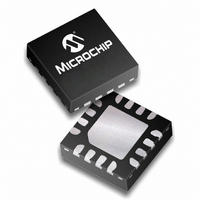PIC16F688-E/ML Microchip Technology, PIC16F688-E/ML Datasheet - Page 477

PIC16F688-E/ML
Manufacturer Part Number
PIC16F688-E/ML
Description
IC PIC MCU FLASH 4KX14 16QFN
Manufacturer
Microchip Technology
Series
PIC® 16Fr
Datasheets
1.PIC16F616T-ISL.pdf
(8 pages)
2.PIC16F688T-ISL.pdf
(204 pages)
3.PIC16F688T-ISL.pdf
(6 pages)
4.PIC16F688T-ISL.pdf
(4 pages)
5.PIC16F688T-ISL.pdf
(688 pages)
Specifications of PIC16F688-E/ML
Core Size
8-Bit
Program Memory Size
7KB (4K x 14)
Core Processor
PIC
Speed
20MHz
Connectivity
UART/USART
Peripherals
Brown-out Detect/Reset, POR, WDT
Number Of I /o
12
Program Memory Type
FLASH
Eeprom Size
256 x 8
Ram Size
256 x 8
Voltage - Supply (vcc/vdd)
2 V ~ 5.5 V
Data Converters
A/D 8x10b
Oscillator Type
Internal
Operating Temperature
-40°C ~ 125°C
Package / Case
16-QFN
Controller Family/series
PIC16F
No. Of I/o's
12
Eeprom Memory Size
256Byte
Ram Memory Size
256Byte
Cpu Speed
20MHz
No. Of Timers
2
Processor Series
PIC16F
Core
PIC
Data Bus Width
8 bit
Data Ram Size
256 B
Interface Type
EUSART, RS- 232, SCI, USB
Maximum Clock Frequency
20 MHz
Number Of Programmable I/os
12
Number Of Timers
2
Maximum Operating Temperature
+ 125 C
Mounting Style
SMD/SMT
3rd Party Development Tools
52715-96, 52716-328, 52717-734
Development Tools By Supplier
PG164130, DV164035, DV244005, DV164005, PG164120, ICE2000, DM163014, DM164120-4
Minimum Operating Temperature
- 40 C
On-chip Adc
10 bit, 8 Channel
Lead Free Status / RoHS Status
Lead free / RoHS Compliant
For Use With
AC164324 - MODULE SKT FOR MPLAB 8DFN/16QFNXLT16QFN1 - SOCKET TRANSITION 14DIP TO 16QFNAC162061 - HEADER INTRFC MPLAB ICD2 20PINAC162056 - HEADER INTERFACE ICD2 16F688
Lead Free Status / Rohs Status
Details
- PIC16F616T-ISL PDF datasheet
- PIC16F688T-ISL PDF datasheet #2
- PIC16F688T-ISL PDF datasheet #3
- PIC16F688T-ISL PDF datasheet #4
- PIC16F688T-ISL PDF datasheet #5
- Current page: 477 of 688
- Download datasheet (3Mb)
1997 Microchip Technology Inc.
Note:
COM0 - SEGx [ON] =
COM0 - SEGx [OFF] =
V
V
D = V
Refer to Figure 25-6
RMS
RMS
V
[ON] =
[OFF] =
RMS
RMS
[ON]
[OFF]
The next example is for Figure 25-6 which is a 1/4 MUX, 1/3 BIAS waveform. For this example,
the values 3, 2, 1 and 0 will be assigned to V
DC voltage, RMS voltage and discrimination ratio calculations are shown in
Example 25-4:
As shown in these examples, static displays have excellent contrast. The higher the multiplex
ratio of the LCD, the lower the discrimination ratio, and therefore, the lower the contrast of the
display.
Table 25-5
and BIAS.
As the multiplex of the LCD panel increases, the discrimination ratio decreases. The contrast of
the panel will also decrease, so to provide better contrast the LCD voltages must be increased
to provide greater separation between each level.
Table 25-5: Discrimination Ratio vs. MUX and Bias
1/2 MUX
1/3 MUX
1/4 MUX
STATIC
V
V
= 3
shows the V
1
3 - 3 + 1 - 1 + 1 - 1 + 1 - 1
1 - 1 - 1 + 1 - 1 + 1 - 1 + 1
(1)
(3)
2
2
V
V
Discrimination Ratio Calculation 1/4 MUX
+ (-1)
+ (-3)
0.333
0.333
0.333
V
= 1.732
OFF
0
OFF
2
2
+ (-1)
+ (1)
, V
ON
2
1/3 BIAS
2
+ (-1)
and discrimination ratios of the various combinations of MUX
0.745
0.638
0.577
+ (1)
V
1
ON
2
2
8
8
+ (-1)
+ (1)
3
2
2.236
1.915
1.732
, V
2
+ (-1)
D
+ (1)
2
, V
V
V
DC
DC
1
Section 25. LCD
2
2
, and V
+ (-1)
= 0
= 0
+ (1)
2
2
0
+ (-1)
+ (1)
respectively. The frame equation,
2
2
=
DS31025A-page 25-19
=
Example
3
V
V
25-4.
25
Related parts for PIC16F688-E/ML
Image
Part Number
Description
Manufacturer
Datasheet
Request
R

Part Number:
Description:
Manufacturer:
Microchip Technology Inc.
Datasheet:

Part Number:
Description:
IC PIC MCU FLASH 4KX14 14SOIC
Manufacturer:
Microchip Technology
Datasheet:

Part Number:
Description:
IC MCU FLASH 4KX14 14TSSOP
Manufacturer:
Microchip Technology
Datasheet:

Part Number:
Description:
IC PIC MCU FLASH 4KX14 14DIP
Manufacturer:
Microchip Technology
Datasheet:

Part Number:
Description:
IC PIC MCU FLASH 4KX14 16QFN
Manufacturer:
Microchip Technology
Datasheet:

Part Number:
Description:
IC MCU PIC FLASH 4KX14 14SOIC
Manufacturer:
Microchip Technology
Datasheet:

Part Number:
Description:
IC PIC MCU FLASH 4KX14 14TSSOP
Manufacturer:
Microchip Technology
Datasheet:

Part Number:
Description:
IC MCU PIC FLASH 4KX14 14DIP
Manufacturer:
Microchip Technology
Datasheet:

Part Number:
Description:
IC PIC MCU FLASH 4KX14 14TSSOP
Manufacturer:
Microchip Technology
Datasheet:

Part Number:
Description:
IC, 8BIT MCU, PIC16F, 32MHZ, SOIC-18
Manufacturer:
Microchip Technology
Datasheet:

Part Number:
Description:
IC, 8BIT MCU, PIC16F, 32MHZ, SSOP-20
Manufacturer:
Microchip Technology
Datasheet:

Part Number:
Description:
IC, 8BIT MCU, PIC16F, 32MHZ, DIP-18
Manufacturer:
Microchip Technology
Datasheet:

Part Number:
Description:
IC, 8BIT MCU, PIC16F, 32MHZ, QFN-28
Manufacturer:
Microchip Technology
Datasheet:

Part Number:
Description:
IC, 8BIT MCU, PIC16F, 32MHZ, QFN-28
Manufacturer:
Microchip Technology
Datasheet:

Part Number:
Description:
IC, 8BIT MCU, PIC16F, 32MHZ, QFN-28
Manufacturer:
Microchip Technology
Datasheet:










